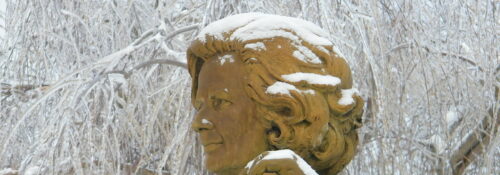
Snow and the Iron Lady: Thatcherball at Hillsdale
Written by Liam Martin
A message went out on the dorm group chat that read, “To celebrate the first big snow of the year, there will be a midnight game of Thatcherball.” I was studying in the library with friends when I got the message, and I couldn’t help but read it out loud. The response was immediate—excitement from my more adventurous friends and groans from everyone else. It was Hell Week, as Hillsdale students affectionately refer to the week before finals, but that was no excuse not to play. Thatcherball is an iconic experience not to be missed.
I had heard about Thatcherball as a prospective student, but I was still fuzzy on the details. I knew that it involved a rugby ball and the statue of Margaret Thatcher that looks over the Quad in front of the Strosacker Science Center.
Invented in the winter of 2009-2010 by then-freshmen Richard Norris, ’13, and Soren Geiger, ’13, the game is a hybrid of rugby and a brawl. When asked about the origins of the game, Norris explained, “I’m from L.A., so I was getting pretty stir-crazy in the winter.” Then, while browsing Wikipedia, he discovered the Eton College “wall game,” a brutal variant on Rugby, and decided Hillsdale should have its own version. “Our goal was to create a game that was as tough and physically demanding as possible,” Geiger added. “It is a great way to pay our respect to the only statue of the Iron Lady in North America.”
The rules are simple: one team tries to touch the rugby ball to the statue by any means necessary, and the other team tries to stop them by any means necessary. Then, after ten minutes, the two teams switch sides, and the defense becomes the offense.
Every score is worth ten points, but there’s a catch. Every article of clothing the scorer is wearing deducts a point from the score. This means the offense tries to play with minimal possible clothing. Shirts and coats are among the first items to go.
There were at least 50 men who showed up to play, and we were quickly divided into two teams. I was on defense first and listened carefully as upperclassmen barked orders. Meanwhile, all eyes were on Central Hall as we waited for the offense to emerge. Suddenly, a shout went up as the offense jogged out from behind the building, tightly packed together, the ball hidden somewhere in their ranks.
Both sides shouted war cries as we charged, and the opposing ranks crashed together. A chaotic melee broke out until the ball appeared, flying through the air. We sprinted to chase down the ball carrier. The next several minutes were utter chaos as the ball was thrown, carried, and chased around the Quad. The defense wasn’t allowed to pick up the ball, but that didn’t stop us from attempting to kick it as far away as possible.
Seven minutes passed this way, until someone threw the ball into the area of the statue, and the offense managed to score. The ruling soon came down: seven points. The offense didn’t score again, so at the end of the ten-minute period, we took a short break for halftime and then prepared to switch sides.
On break, we quickly drew up a game plan. Rather than try to force our way to the statue, as our opponents had done, we used speed and deception. Behind Central Hall, we formed into our ranks and charged. The snowy brawl erupted as before, until, to the defense’s dismay, five of our fastest players sprinted from the other side of Central Hall and headed right for the statue. The defense, realizing they had been tricked, dashed to make sure the ball carrier wouldn’t get close to the statue. In the process, they never saw the lone figure jogging across the Quad, the ball hidden behind his back.
By the time they recognized their mistake, it was too late. The real ball carrier punted the ball as hard as he could, sending it right into the mob of players surrounding the statue. A terrific struggle ensued, but resistance was futile, and the ball struck the statue with a thud. We all waited in suspense, trying to figure out who had thrown it and how many points it would be worth. When it was announced, we all erupted with cheers: eight points.
It was a hard-fought victory. As we made our way back to our dorms, we were gasping for breath in the cold air, nursing bumps and bruises, and thoroughly exhausted. But every one of us agreed it was worth it. Warm showers and 2:00 a.m. cups of tea were the order of the day, but we were all proud of our accomplishments, win or lose.
We had fought valiantly, against each other, the snow, the icy wind, and our own mental limits. We were a brotherhood formed in snow and struggle. We didn’t flinch from the cold, and we couldn’t help but think we had made the Iron Lady proud.
Meanwhile, for the inventors of the game, the fact that it is still being played by new generations of Hillsdale students is a sign of their continued impact on campus. As Norris explained, “I think it’s great that it is still being played. The spirit of the game was fitting with the ethos of the College, which is self-government. We want people to make the right decision, but we also want to give them the freedom to have fun.”
Liam Martin, ‘25, is a native of rural Ohio and plans to major in History. In his free time, he enjoys coffee, Shakespeare, Latin chant, and debating politics and religion with whoever will listen.
Published in February 2022
